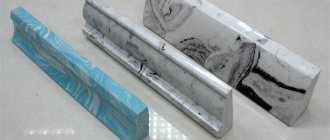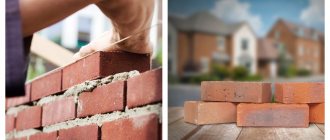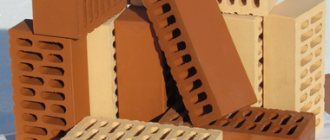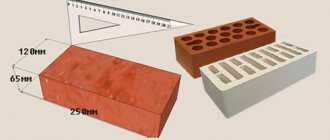Construction brick does not lose its popularity. Today, hollow bricks predominate on construction sites. Its second name is effective or slotted. It is so called because of the presence of voids, due to which less raw materials are spent on its production and the overall weight of the structure is reduced.
In different climatic conditions, especially in ours, temperature differences during the off-season period are quite large. To prevent the walls from freezing in winter, you have to make them thicker. An increase in wall thickness is associated not only with weather conditions, but with the load that it can withstand and with sound and heat conductivity. An increase in the amount of material leads to an increase in the price of the construction project, as well as to an increase in the overall weight of the structure. It is much more expedient to use hollow ones where their use is permissible.
Ceramic brick
Hollow brick - main varieties
There are 3 types that are most common on construction sites:
- Red ceramic brick;
- Silicate (White);
- Hyper-pressed.
In turn, all of them can be either full-bodied or empty. Their use is regulated by the requirements of the project. Solid ones have increased strength and are used for load-bearing walls or foundations. The advantage of hollow ones is the voids filled with air, due to which the thermal conductivity of the material is reduced. They are lighter, cheaper, but less durable.
The density of solid ceramic bricks is about 1600-1800 kg per cubic meter. Thermal conductivity up to 0.5 W in mK. The density of hollow is on average from 1100 to 1500 kg per m3, but the thermal conductivity is from 0.22 to 0.26 W per mK. To increase the thermal conductivity, slag or perlite is added to the masonry mortar. This allows you to increase the figure by 10-15 percent.
Hollow brick
A few words about production
The production of hollow blocks is a little more complicated than solid ones. The holes are created using special cores installed on a hydraulic press mold. The raw material for ceramics consists of clay with a moisture content of 10 to 15 percent. Hollow ones have a major drawback - low frost resistance. For this reason, they should not be used in basements or areas with high humidity. According to GOST, a material with more than 15 percent voids is hollow. Typically this figure is about 30-40 percent, with different shapes and sizes.
Hollow ones are made of the following types:
- Ceramic (red). Standard, most common material. It is made by firing a clay mixture with various additives. It has good decorative properties, strength and thermal insulation.
- Thermally efficient. The effectiveness of such material lies in significant cost savings while ensuring maximum performance. The thermal insulation property of the material allows the masonry to be erected in one brick. The low weight of the brick allows you to reduce the pressure on the foundation, reducing the overall weight. Walls made of this material maintain a constant room temperature in winter and summer.
- Porous. Mainly used as a facing material. It has good noise insulation and heat insulation properties due to its porous structure. Like effective, it reduces the weight of the structure due to the presence of pores.
- Foam diatomite. It can withstand high temperatures, which is why it is used in the construction of stoves or fireplaces. It can be used like a regular building brick, but the costs will be higher.
- Cement-sand. Clay is not used in the manufacture of this type. Additional additives are added to the composition, which increase the strength of such bricks. The cost of producing such material is several times less than the production of standard ceramic or silicate.
Features of hollow type ceramic bricks
Ceramic brick is a well-known leader among building materials intended for the construction of walls, fences, columns and other enclosing structures. Given that it has a fixed heat capacity, manufacturers have figured out how to increase the parameter without excessively increasing the cost. This is a well-known hollow or slotted brick.
Characteristics and types
The well-known white and red brick is an artificial piece of stone used in construction. But if the first is produced by pressing and subsequent steaming in an autoclave, then the second necessarily goes through the firing stage. It is because of this that it acquires its characteristic coral hue and hardness. Products come in two types:
1. Solid – monolithic blocks of standardized sizes.
2. Hollow - with cavities 13-49% of the total volume.
Slotted ceramic bricks are manufactured:
- By depth: with through voids or closed on one side.
- Shape: with round openings with a diameter of up to 16 mm, rectangular or oval slots with a cross-section of no more than 12 mm.
- By positioning: longitudinal or transverse cavities.
The density of all varieties depends only on the composition of the raw materials. Any production method involves extrusion, so the ceramics are quite dense and durable. The main difference lies in the scope of application. Facing ceramic hollow brick has a density index of 1300-1450 kg/m3, and ordinary or working brick - 1000-1400 kg/m3. In addition, front artificial stone, as a rule, has a flat, smooth or corrugated surface, while construction stone may have unevenness, notches, chips and other minor defects.
Why do builders prefer to buy hollow ceramics? By filling the voids with a mass of mortar or formed air “plugs”, the thermal conductivity of the building material is significantly reduced. If a solid product has a coefficient of 0.5-0.8 W/m*K, then a slotted product has a coefficient of 0.34-0.43 W/m*K. The density of the material is 1100-1150 kg/cubic. m.
The characteristics of the so-called porous hollow brick deserve special attention. Combustible impurities (sawdust, straw, polystyrene balls) are introduced into the raw materials, which burn during the firing process, leaving in their place pores filled with a mixture of gases. This type of artificial stone has the lowest thermal conductivity coefficient - 0.22 W/m*K. It’s not for nothing that they gave it the name “warm ceramics”. However, such a significant advantage affects the strength of porous bricks. It is quite fragile and quickly begins to crumble when struck or nailed. Therefore, additional cladding with conventional ceramic products is required.
Standard ceramic hollow bricks have quite acceptable performance characteristics:
1. Compressive strength – M75-M300. For a private house with a height of 2-3 floors, products labeled up to M100 are sufficient. It is better to construct multi-storey buildings from grade M150 and higher.
2. Frost resistance – F15-F75.
3. Water absorption coefficient – 4-15%. The exact value depends on the density and degree of firing of the brick.
As mentioned above, a hollow ceramic product has a low thermal conductivity coefficient, but for the housing stock of the Russian Federation the standard is 0.024 W/m*K. That is, it turns out that to achieve it, the thickness of the walls should approach 1 meter. This is unrealistic, so brick walls are insulated with any type of thermal insulation materials with the dew point moving outside the brick (facade thermal insulation).
You can buy ceramic blocks of standard dimensions from all dealers, as specified in GOST 530-2007:
1. Single or normal format: 250x120x65 mm.
2. One and a half or 1.4 NF: 250x120x88.
3. Double or 2.1 NF: 250x120x138.
Large formats have been developed for porous ceramic stone:
- Porous 4.5NF: 250x250x138 mm.
- Superporous 10.8NF: 380x253x219.
- Porous additional 11.3NF: 398x253x219.
- Large 14.5NF: 510x253x219.
All these sizes, as well as non-standard ceramic products made to order, are offered for purchase only by large manufacturers. Local factories are limited to 3-4 standard sizes.
Features of laying hollow ceramics
Hollow brick is installed in the same way as solid brick. You need to stretch a cord along the foundation tape around the perimeter, which will serve as a kind of level. The brick is soaked so that it does not “pull” moisture from the cement-sand mixture.
The solution is applied to the base in a layer of up to 1 cm, the brick is laid, tapped and leveled with a hammer or the back of a trowel. Another stone is also installed 1 meter from it, and so on around the entire perimeter - the “beacons” are ready. Next, the openings are filled with ceramic products. The second row is laid in a checkerboard pattern, overlapping the joints of the previous one. The thickness of the seams is controlled by a wooden block - ordering.
Price
The price of hollow ceramic blocks depends on density, strength, dimensions and manufacturer. The table below shows cost indicators for different types of working brick products in Moscow and the Moscow region.
| Dimensions | Strength | Cost, rub/piece |
| Single NF | M100/M150 | 12-15 |
| One and a half 1.4NF | M125/M150 | 9-16 |
| Dual 2.1NF | M100/M125 | 14-17 |
| Porous 4.5NF | M125/M150 | 18-21 |
| Superporous 10.8NF | M75/M100 | 94-100 |
| Porous additional 11.3NF | M75/M100 | 98-110 |
| Large 14.5NF | M75/M100 | 125-130 |
Structure and forms
Hollow bricks differ not only in their material and volume of voids, but also in their external shape and structure:
- Material with horizontal voids. When laying such a material, it is necessary to take into account its low strength due to its structure. They are suitable for filling partitions in monolithic frame houses.
- The facing brick is hollow. Used for cladding building facades. Its use will be more expensive than plastering, but the durability of such a facing material is higher.
- Textured. This type is marked with a pattern or relief, usually on the spoon or butt part. It has a beautiful appearance, mainly using the front hollow single one.
- Curly. It has beveled corners, columns and arches are built from it, and various decorative elements of the building are erected.
Linear dimensions of brick
Hollow bricks, like solid bricks, have standard sizes, regulated by GOST. According to GOST, the main dimensions are:
- Single 250x120x65 mm;
- One and a half 250x120x88 mm;
- Double hollow 250*120*138 mm.
How much does a brick weigh?
The ceramic one-and-a-half weighs approximately 2.1 to 2.5 kg.
GOST also provides additional dimensions for hollow ones using the example of ceramic:
- Euro standard 250 by 85 by 65 mm;
- Single ceramic modular 288 by 138 by 65;
- The ceramic hollow thickened brick has dimensions of 510 by 253 by 219;
- Additional hollow construction 398 x 25 x 219.
The first three are the most popular types. This is due to their ease of use (one brick fits in your hand) and the high speed of masonry construction. Double brick significantly speeds up construction.
Hollow ones are also divided according to the following criteria:
- According to the deepening of the voids: the void is through or closed on one side;
- According to the shape of the holes: round holes, rectangular or oval;
- By placement relative to the bar: longitudinal or transverse.
You need to pay attention to the features of porous bricks; they fall under the standard criteria for hollow bricks. At the manufacturing and pressing stage, combustible components (wooden sawdust or straw) are added to the mixture. During heat treatment they burn, releasing gas. This type has better thermal conductivity (about 0.22 W per mK), but is inferior in strength. This material crumbles from mechanical damage and precipitation, so it needs external cladding.
Classification of Hollow Bricks
Ceramic and clay hollow bricks
are widely used Both options are made from clay. The difference is that ceramic products are fired in special kilns, which makes the product stronger and more resistant to moisture.
Simple clay brick does not undergo this treatment. After molding, it is dried for a long time to make the material harder. The performance qualities of this material are noticeably worse than those of ceramics, and it is not suitable for use in cold regions and areas with damp air. It cannot be used to build high-rise buildings, but one-story buildings for residential or commercial purposes can be made. Such a house can last up to 25 years. If red hollow ceramic brick can have a strength grade of M150-200 , then unfired brick, as a rule, cannot even be assigned M50 . However, the low price and ease of production of raw brick (you can even mold it yourself) make it popular in dry areas with warm weather.
There are other variations of building hollow bricks, for example, silicate , made from a sand-lime mixture. It stands out with its light color. porous bricks are also produced . They differ from ordinary ceramic ones in that before pressing, flammable additives (sawdust, straw, etc.) are introduced into the mixture. When fired, they release gas and form pores. As a result, the product is lighter and retains heat well. But its strength is insufficient, so construction from such material requires external cladding.
Less common options include:
- Foam diatomite blocks that can withstand elevated temperatures well. Thanks to this property, they are suitable for laying out fireplaces and stoves. You can also make buildings from them, but this is usually not practiced, since their cost is higher than that of conventional bricks.
- Textured products that have relief patterns on the surface and have increased decorative qualities.
- Facing brick used for finishing facades.
- Shaped options with beveled corners. They are purchased for the installation of arched and other decorative structures.
Lycefoy
Porous
Textured
Diamite foam
Large-sized products are usually called blocks. Buildings are built faster than using standard size bricks. Other advantages of the blocks are good thermal insulation properties, strength and reduced cement consumption during installation.
Ceramic blocks
GOST defines large-sized products as ceramic blocks. Laying hollow bricks in the form of a block increases the speed of construction. The main characteristics of the block are thermal conductivity (about 0.15-0.20 W per mK) and density equal to 600 kg per cubic meter. Due to the size of the blocks, the consumption of cement mortar is reduced, which when using hollow double bricks can be up to 15% of the volume of the masonry.
GOST sets the following block sizes:
Main characteristics of hollow bricks
- The same requirements apply to a hollow one as to a solid one. The strength indicator is defined as grade (M). They produce grades 100, 125, 150, 175 and 200. For low-rise buildings, grade 100 is used, for high-rise buildings, at least grade 150 is used. The most popular brand is 150.
- Frost resistance. Indicates the material's ability to withstand multiple freeze-thaw cycles. Identified by the letter (F). For our latitudes, it is better to buy with a frost resistance rating of at least F 35.
- Water absorption. The ability of a material to absorb moisture. The frost resistance index also depends on this criterion.
- Degree of emptiness. Indicates the percentage of voids in a brick from its total volume.
What sizes are solid bricks?
Building brick is the most common modern material, characterized by increased strength characteristics and durability. Based on its modular dimensions, stone structures are designed and their dimensions are determined. A brief description of solid brick and an overview of current prices for it will help developers solve constructive problems in conducting architectural projects.
List of modular sizes of ceramic solid blocks
The thickness of masonry products determines two standard formats.
1. Single – 250 x 120 x 65 mm. The optimal aspect ratio ensures ideal placement of elements in the masonry. The unified dimensions of a solid single brick make it possible to easily cope with the installation of any interface units of building structures.
2. One and a half – 250 x 120 x 88 mm. The use of thickened products significantly reduces the consumption of concrete mortar, reduces masonry time and reduces labor costs. The actual sizes of the stones exceed their single counterparts by only 30%. One and a half solid red brick is the most popular format.
Fireproof blocks are produced not only in classic sizes, but also in non-standard designs. There are fireclay stones in the shape of trapezoids, wedges, and arches.
Varieties
A solid brick is a monolithic rectangular block with right angles and sharp edges of standard sizes. The main raw materials used in production determine the belonging of building elements to a specific type.
1. Red is a ceramic stone made from a clay mixture that is fired at high temperatures. The modular dimensions of finished products are maintained in accordance with current GOSTs.
2. White – sand-lime brick produced by autoclave processing of lime-sand blocks. It is characterized by a reduced level of strength, softness and low weight. Solid silicate stones are manufactured according to generally accepted dimensional standards.
3. Fireclay - a fireproof block based on clay with the addition of fireclay, coke, graphite or quartz additives. Each size is intended for specific purposes: laying home fireplaces, chimneys, building vaults and thresholds of blast furnaces. The price of fireclay products is significantly higher than regular ones.
Brick characteristics
Symbols of building elements contain information on name, type, as well as strength and frost resistance grades. The selling price of solid facing bricks is formed from a set of technical parameters.
1. Strength – expresses the ability of a particular type of product to resist various types of deformation. The marking indicates the maximum weight load in kilograms that 1 cm3 of material can withstand. Denoted by the letter “M” and a set of numbers. In practice, there are solid stone elements with grades ranging from M75 to M300.
2. Frost resistance - the ability of bricks to withstand the frequency of freezing and thawing processes in a state of complete saturation with moisture. The number of cycles after which technical characteristics begin to change is considered an indicator of the frost resistance of stones. Marked with the letter “F” followed by a numerical designation from 25 to 50.
Areas of application and prices
Depending on the purpose, there are three types of bricks:
- construction – the main material for laying functional structures of various structures: foundations, walls, pillars, columns;
- facing – used for decorative design of building surfaces, characterized by a wide variety of shades, textures and increased cost;
- stove - especially durable, designed for arranging fireplaces, stoves, barbecues.
A positive property of full-bodied products is the complete absence of chemically active additives in their composition. The content of natural components determines the preferential right to use building materials for the construction of residential buildings.
| Name | Strength grade | Price including VAT, rub/piece |
| Single red | M 100 | 6–11 |
| M 125 | 7–11 | |
| M 150 | 7–14 | |
| M 200 | 13–18 | |
| One and a half red | M 125 | 13–16 |
| M 150 | 12–16 | |
| Single silicate | M 150 | 8–11 |
| M 200 | 8–12 | |
| Sesquisilicate | M 150 | 9–14 |
| Single fireproof | M200 | 30–76 |
Building hollow description
With a total volume of voids of 45%, the maximum grade is 150. The grade of brick greatly depends on the presence of voids. So, if the total volume of voids is 22%, 150 grade is not used at all.
Hollow brick is an excellent alternative to more expensive and heavier solid bricks. Hollow brick, which weighs significantly less, still has a number of disadvantages, which makes it advisable to combine it with other types of materials. If all technical requirements for construction are met, a house built from hollow brick will last as long, or maybe longer, as one made from solid brick.
Differences between hollow bricks and solid bricks
Externally, hollow brick differs from solid brick by the presence of cracks in it, through holes or holes closed on one side of different shapes - rectangular, round, oval. In addition, it usually has a smoother surface and regular shape, which is due to a special manufacturing method.
External differences are only in the presence of voids
But the differences are not limited only to external features. Voids give the material special properties and change its characteristics.
- Hollow building bricks have less weight, since their production requires less raw materials. Accordingly, structural elements made of hollow bricks place less load on bases and foundations, and the reduced weight makes transportation easier.
For reference. The volume of voids from the total volume of brick can range from 12 to 50%. Accordingly, the consumption of raw materials is reduced.
- The air in the voids is an excellent heat insulator. It reduces the ability of walls to transfer heat from interior spaces to the outside when the air temperature between them differs dramatically. In other words, the thermal conductivity of a hollow brick is lower than that of its solid counterpart.
- In addition, air-filled voids improve the sound insulation properties of the material.
It is important. The heat and sound insulation characteristics of the material during masonry are fully preserved only if the air from the voids is not displaced by the masonry mortar. Therefore, its density must be carefully monitored.
Hollow brick masonry loses thermal efficiency when filling the voids with cement mortar
- Since less raw materials are used per unit of production, its price is also lower.
Solid and hollow bricks - characteristics for comparison
All of the listed properties can be attributed to the positive differences and advantages of hollow stones. But there are also disadvantages that cannot be ignored.
- The presence of voids reduces the strength of the brick; it is not able to withstand high loads. Therefore, the instructions in most cases do not allow its use for the construction of high load-bearing walls and other loaded structures.
- Hollow and porous material absorbs moisture much better and faster. Freezing, the water accumulated in the voids expands and destroys its structure. It is for this reason, as well as because of its low strength, that hollow brick cannot be used for constructing foundations, laying walls of basements and basements exposed to active groundwater. And also for the construction of load-bearing walls of multi-story buildings.
Such a plinth may not withstand the weight of the building and may collapse from moisture.
- Voids in the body of the brick complicate the installation of other building elements and structures (for example, door frames, utilities and pipes), as well as the fastening of hanging furniture and equipment to the walls. To do this, it is necessary to use special fasteners for hollow bricks and hollow building blocks.
Chemical anchor is one of the most reliable types of fasteners for hollow products











